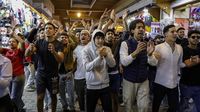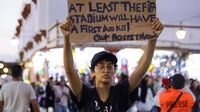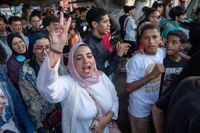For five consecutive nights, Morocco has witnessed a surge of anti-government demonstrations, as thousands of young people have taken to the streets in cities across the country, voicing their anger over failing public services and government spending priorities. What began as peaceful protests quickly escalated into violence and destruction, marking some of the largest and most disruptive unrest Morocco has seen in recent years.
According to reports from AFP and Bloomberg, the demonstrations have been fueled by mounting frustration over the dire state of Morocco’s schools and hospitals, even as billions of dollars are being poured into preparations for the 2030 men’s soccer World Cup. The youth-led movement, which has harnessed the power of social media platforms like TikTok and Discord, has organized rallies under the banner of the Gen Z 212 protest movement—a nod to Morocco’s country code and the digital generation driving the unrest.
The protests first erupted late last week, with young Moroccans flooding the streets of Rabat, Casablanca, Oujda, and smaller towns such as Inzegane and Ait Amira. By September 29, the demonstrations had already turned volatile, with members of the Royal Gendarmerie in Lqliaa, near Agadir, shooting and killing two people and wounding others as they repelled a group suspected of attempting to steal their weapons and ammunition. The state news agency MAP confirmed these were the first deaths linked to the youth-led protests, which have grown in intensity and spread rapidly throughout the country.
The core grievances of the protesters are clear: they are furious about the chronic underfunding and deterioration of essential public services, particularly healthcare and education. Many point to the government’s lavish spending on new stadiums and infrastructure for the 2030 World Cup as evidence of misplaced priorities. As one chant echoed through the crowds, “Stadiums are here, but where are the hospitals?” This sentiment has only deepened following the recent deaths of eight women in a public hospital in Agadir, a tragedy that has become a rallying cry for the movement.
On September 30, violence flared in several cities, with protesters clashing with security forces, hurling rocks, and setting vehicles ablaze. In Oujda, the largest city in eastern Morocco, a police vehicle reportedly rammed into demonstrators, leaving one person injured, according to local human rights groups and the state news agency. The unrest was particularly severe in regions far from Morocco’s major development projects, where jobs are scarce and social services are stretched thin.
The Moroccan Interior Ministry has responded with a heavy hand, declaring that the anonymously organized protests lacked authorization and would be dealt with “rigorously and firmly.” Over the course of the nationwide demonstrations, police detained 409 people, including dozens of minors. The ministry also reported that 263 law enforcement officers were injured, 142 police vehicles were damaged, and 20 private cars were destroyed. Additionally, 23 civilians sustained injuries during the clashes.
Among those arrested were 37 protesters in Oujda on September 29—six of them minors—who were scheduled to appear in court on October 1. The Moroccan Association for Human Rights (AMDH) has documented hundreds of arrests, many of which were captured on video by local media. Some detainees were reportedly apprehended by plainclothes officers during interviews, raising concerns about due process and transparency.
International organizations have taken notice. Amnesty International’s regional office released a statement urging Moroccan authorities to engage with the “legitimate demands of the youth for their social, economic, and cultural rights and to address their concerns about corruption.” The rights group also called for restraint and respect for peaceful protest, warning that further repression could inflame tensions.
The Gen Z 212 movement has drawn support from prominent Moroccan figures, including the national soccer team’s star goalkeeper Yassine Bounou and the rapper El Grande Toto. Their public backing has helped galvanize the movement and amplify its message both at home and abroad. In a statement published on Discord, the organizers wrote, “The right to health, education and a dignified life is not an empty slogan but a serious demand.” They cited King Mohammed VI’s own words and implored protesters to remain peaceful, while criticizing what they called “repressive security approaches.”
Despite the unrest, the Moroccan government has denied accusations that World Cup spending is being prioritized over critical public infrastructure. Officials argue that many of the problems facing the health sector are inherited from previous administrations and insist that reforms are underway. According to CNN, the governing parliamentary majority announced it would meet on October 2 to discuss healthcare and hospital reforms, with Prime Minister Aziz Akhannouch set to lead the session. The government has promised to address deficiencies in social services, but many protesters remain skeptical, citing years of unfulfilled promises and a lack of tangible progress.
The protests have not gone unnoticed internationally, with comparisons being drawn to similar youth-led movements in countries like Nepal and Madagascar. In Morocco, the movement’s decentralized, digitally coordinated nature has made it difficult for authorities to contain. Organizers have used encrypted channels and gaming platforms to coordinate actions, share updates, and avoid surveillance—a tactic that reflects both the creativity and determination of the country’s younger generation.
As the demonstrations continue, the country finds itself at a crossroads. The government’s response—balancing force with promises of reform—will likely determine whether the unrest abates or intensifies in the days ahead. For many young Moroccans, the protests are about more than just public services or World Cup stadiums; they are a demand for dignity, opportunity, and a voice in shaping their country’s future.
With the world’s eyes turning to Morocco ahead of the 2030 World Cup, the government faces mounting pressure to prove that it can deliver not just world-class stadiums, but also the basic services and freedoms its citizens demand. As the Gen Z 212 movement grows in strength and determination, the coming weeks will test the resilience of Morocco’s institutions—and the resolve of its youth.



